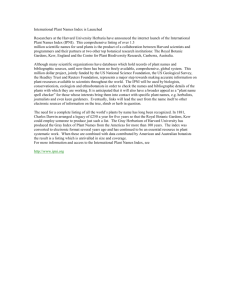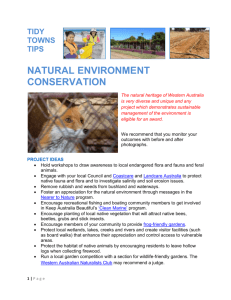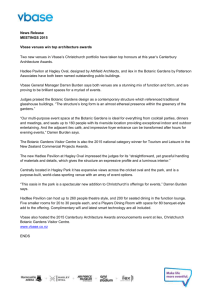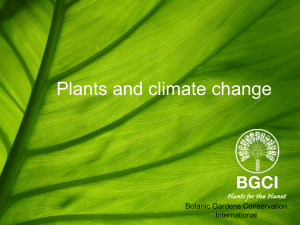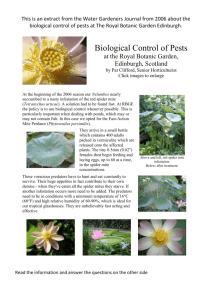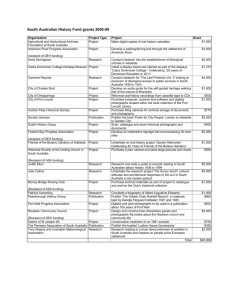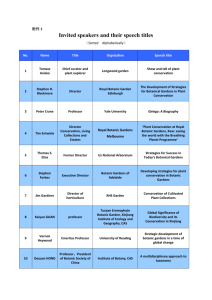Dr Phillip J. Ainsley - Royal Botanic Gardens, Kew
advertisement
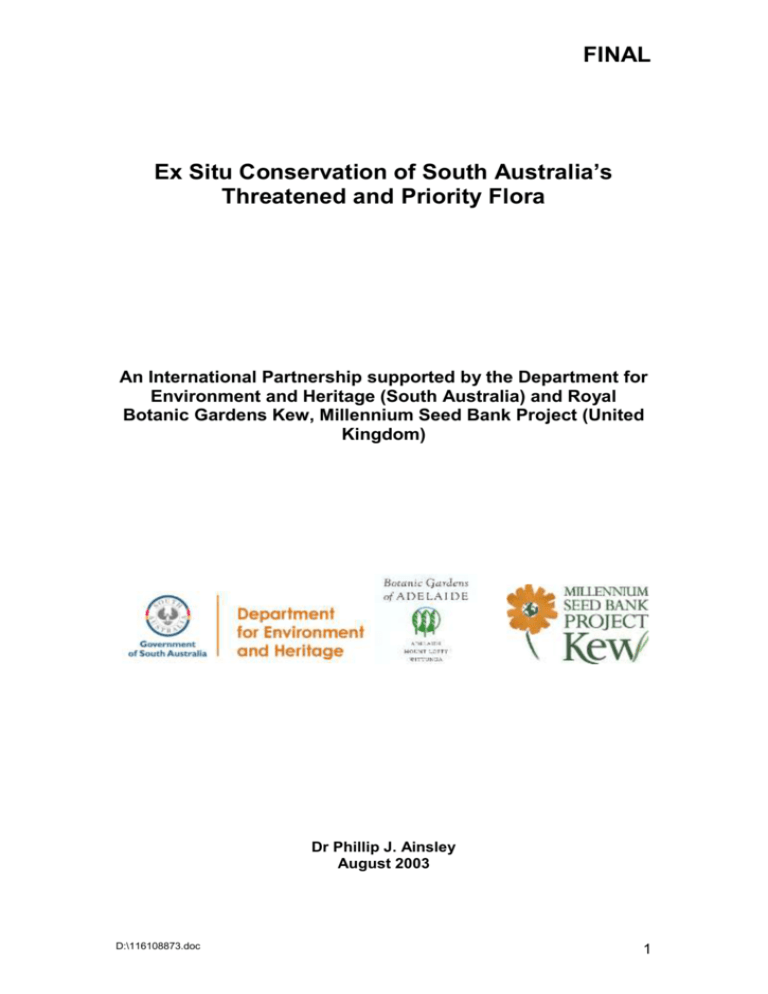
FINAL Ex Situ Conservation of South Australia’s Threatened and Priority Flora An International Partnership supported by the Department for Environment and Heritage (South Australia) and Royal Botanic Gardens Kew, Millennium Seed Bank Project (United Kingdom) Dr Phillip J. Ainsley August 2003 D:\116108873.doc 1 FINAL 1. PROJECT SYNOPSIS The Project synopsis provides background information related to the development of an international plant conservation partnership between the government of South Australia and the Royal Botanic Gardens Kew Millennium Seed Bank Project. (The Department for Environment and Heritage through the ‘Botanic Gardens of Adelaide’ is responsible for administering the Project on behalf of the government of South Australia (referred to in this synopsis as “the Botanic Gardens of Adelaide”)). It outlines the Project purpose and outputs, summarises the major activities, and highlights the specific benefit sharing and capacity building components. The Project synopsis also defines the context of the Project in relation to global, national and state legislation/strategies, and considers collection priorities to pursue these mandates. Finally it summarises the roles and responsibilities of the Partners and describes the required inputs needed for the effective implementation and delivery of the Project. The Project synopsis forms Annex 1 of the Access and Benefit-sharing Agreement between the State of South Australia (represented by the Board of the Botanic Gardens and State Herbarium, Adelaide, Australia and the Minister for Environment and Conservation) and the Royal Botanic Gardens, Kew, United Kingdom. 1.1 BACKGROUND The Botanic Gardens of Adelaide is part of the Science and Conservation Directorate within the Department for Environment and Heritage. The Department for Environment and Heritage is the principal nature conservation agency within South Australia. In 2002, the Botanic Gardens of Adelaide developed a Strategic Plan (20022005) focused on becoming an international leader in horticulture for arid and semi-arid environments. This focus is because approximately 75% of South Australia is considered to be arid/semi-arid; defined as areas frequently affected by drought receiving 200 to 350 mm of rainfall per annum (Read, 1994). One of the key objectives in the Strategic Plan is plant conservation. Specifically, Section 3.2 states that the Gardens will contribute to the conservation of South Australia’s threatened flora using ex situ methodologies to complement statewide in situ conservation programs. To achieve this objective, a dedicated ex situ seed research facility (Seed Conservation Centre) has been established. The primary objective of the Centre is to undertake seed collections of priority plant species throughout the state for the establishment of long-term seed conservation collections, and develop germination and storage protocols for each taxon collected. The Seed D:\116108873.doc 2 FINAL Conservation Centre is the only unit within the state undertaking this type of research with native plant species. In addition, the strategy of the Seed Conservation Centre has been tightly aligned with state and national legislation, and closely links with South Australia’s regional biodiversity plans. Since its establishment the unit has been actively collaborating with regional groups and research teams within the state to complement existing programs where the focus has been on in situ plant conservation of native plant species. The Millennium Seed Bank Project is a 10-year global plant conservation initiative managed by the Seed Conservation Department at the Royal Botanic Gardens, Kew, in the United Kingdom. Bilateral research, training, and capacity building relationships are supported at an international level in order to advance the conservation of wild plant species. The Millennium Seed Bank Project aims to collect and undertake long-term seed storage from 10% of the world’s seed bearing flora (primarily in arid and semi-arid regions) by 2010. The Botanic Gardens of Adelaide is committed to the development of integrated plant conservation programs and the implementation of species recovery within South Australia. The establishment of a partnership between the Botanic Gardens of Adelaide and the Millennium Seed Bank provides a unique opportunity for training, bilateral research and the dissemination of information at both a national and international level. In addition collaboration between the two institutions will provide an opportunity to increase the capacity of the Seed Conservation Centre to effectively conserve South Australia’s threatened and priority plant species using ex situ techniques. In Australia there is already one such partnership successfully operating within Western Australia. Discussions of similar partnerships are also in progress between the Royal Botanic Gardens Kew and plant conservation groups/agencies in New South Wales, Queensland, Northern Territory and Tasmania. It therefore seems timely to develop this Partnership between the Royal Botanic Gardens Kew and the Botanic Gardens of Adelaide (“The Partners”) addressing plant conservation through an expanded seed collecting program and developing improved long-term seed management and storage protocols for South Australia’s threatened and priority plant species. A six-year collaborative program (“The Partnership”) to strengthen and expand the existing ex situ seed conservation and research program in South Australia has been developed. The Partnership will be managed in two phases. Phase one (“The Project”) will operate for three years commencing from the date of signing of the Access and Benefit Sharing Agreement. Phase one of The Partnership will focus on capacity building, staff training, and enhancing the Seed Conservation D:\116108873.doc 3 FINAL Centres ability to collect and manage seed. This will generate outputs that will form the basis for the development of a second phase to run for a similar time period that shall be focused on the development of a dedicated research program to support on going collection activities and long-term storage of conservation collections. 1.2 PROJECT DESCRIPTION 1.2.1 Project Goal The development of an effective ex situ conservation program for South Australia’s plant biodiversity at the Botanic Gardens of Adelaide Seed Conservation Centre. 1.2.2 Project purpose To support plant conservation within South Australia by complementing in situ plant conservation activities at a state level by establishing a program of increased seed collection for targeted species, and undertaking research to understand the germination and long-term storage requirements for seed of collected species. 1.2.3 Project outputs (Phase 1) The Project purpose will be addressed through the delivery of four Project outputs: 1. An enhancement and strengthening in the capacity of the Botanic Gardens of Adelaide Seed Conservation Centre to collect and conserve South Australia’s threatened and priority plant species; 2. An increase in the number of long-term seed conservation collections of threatened and priority South Australian flora using the most current and appropriate seed banking and collecting technologies; 3. The development and adoption of improved seed management procedures for long-term conservation collections held at the Seed Conservation Centre; 4. Improved availability of seed management information and procedures for South Australian plant species to end-users. 1.2.4 Project activities (Phase 1) These Project outputs will be delivered through the implementation of activities including: D:\116108873.doc 4 FINAL A. Recruitment of key seed collecting staff by the Botanic Gardens of Adelaide; B. Training of Botanic Gardens of Adelaide technical staff in seed conservation techniques through formal courses and research attachments at the Millennium Seed Bank in the United Kingdom; C. Procurement of specific seed testing and cleaning equipment; D. Collection of seed from South Australia’s threatened and priority plant species in an ecologically sustainable and ethical way, consistent with Action 1.9.3 of the National Strategy for the Conservation of Australia’s Biological Diversity; E. Seed germination testing on collected accessions to determine viability and facilitate long-term storage; F. Conducting research experiments to develop methods to overcome dormancy issues in species identified as being difficult to germinate; G. The implementation of an efficient monitoring program to determine the effect of storage conditions on long-term conservation collections; H. Storage of duplicate seed collections and associated herbarium voucher material in South Australia and the United Kingdom for long-term conservation; I. Sharing seed viability and germination results carried out on material at both the Botanic Gardens of Adelaide and the Royal Botanic Gardens Kew; J. The involvement of students from South Australian Universities with seed testing and research; K. The establishment of a network of regional volunteers in South Australia to assist in field monitoring and seed collection; L. Conducting a series of seed techniques training workshops for regional staff and volunteers; M. Dissemination of data generated during The Project by attending conferences, publication of articles in peer reviewed journals, and availability of information on the Botanic Gardens of Adelaide web site. 1.3 BENEFIT-SHARING The Partners have identified the following mutually acceptable benefitsharing activities of the Project: Provision of additional Project staff at the Botanic Gardens of Adelaide: The Royal Botanic Gardens Kew will finance the recruitment of 1.5 full time equivalent technical officers to be based at the Botanic Gardens of Adelaide to support seed collection and conservation activities for the duration of the Project; D:\116108873.doc 5 FINAL The Botanic Gardens of Adelaide will finance the recruitment of a 0.5 full time equivalent technical officer to be based at the Botanic Gardens of Adelaide, and the involvement of the equivalent of at least a 0.5 full time post spread over a number of field regions within South Australia to support seed collection and conservation activities for the duration of the Project; Training of Botanic Gardens of Adelaide and Project related staff: Royal Botanic Gardens Kew will facilitate and finance: Two Botanic Gardens of Adelaide technical staff to participate in the Royal Botanic Gardens Kew “International Diploma in Seed Conservation Techniques” to be hosted by the Royal Botanic Gardens Kew Seed Conservation Department during September 2004; One Botanic Gardens of Adelaide research staff member to undertake a collaborative research attachment to the Royal Botanic Gardens Kew during the Project Period; Two South Australian University students to undertake Honours level research projects at the Botanic Gardens of Adelaide during the Project; Conducting a series of seed techniques training courses in South Australia for regional field staff and volunteers; An annual visit to an interstate Millennium Seed Bank Project Partner by a Botanic Gardens of Adelaide technical staff member during the project. Provision of equipment: Royal Botanic Gardens Kew will finance the purchase of: One non-destructive equilibrium relative humidity meter; One -18C freezer; One vacuum seed cleaner; Two germination cabinets; One digital camera; One hand held computer; One GPS unit; Upgrade of Botanic Gardens of Adelaide field collecting kit. This equipment will remain the property of the Government of South Australia at the conclusion of the Project. Seed collection costs: Royal Botanic Gardens Kew will finance field costs (vehicle and staff allowances) associated with Botanic Gardens of Adelaide technical staff for a total of 180 field days over an estimated 56,880 kilometres D:\116108873.doc 6 FINAL during the Project. Additional funds will also be provided for the involvement of regional Science and Conservation Directorate staff (vehicle and staff allowances) for a total of 300 field days over an estimated 60,000 kilometres during the Project. 1.4 PROJECT CONTEXT AND RATIONALE Since European settlement, the impact of vegetation clearance, introduced plants and animals, and unnatural fire regimes have cumulatively resulted in the fragmentation and degradation of ecosystems throughout Australia. It is therefore imperative that remnant vegetation be effectively conserved and degraded landscapes restored in a effort to stem the rapid loss of plant and animal biodiversity that is currently being experienced at a national level. In South Australia, 21 plant species previously native to the State are now considered extinct, with the number of regional extinctions being significantly higher (Lang and Kraehenbuehl, 1987). In 2002 delegates at the Sixth meeting of the Conference of the Parties to the Convention on Biological Diversity (CBD) agreed to a Global Strategy for Plant Conservation (GSPC). The strategy is binding for all signatories to the CBD, including Australia. The GSPC comprises sixteen targets to be achieved by 2010, with each target specifically designed to guide and measure the conservation of threatened plant species and ecosystems. The Project is directly consistent with Target 8 of the GSPC: “60 per cent of threatened plant species in accessible ex situ collections, preferably in the country of origin, and 10 per cent of them included in recovery and restoration programs”. Storage of seed (or seed banking) is arguably the most efficient and effective means of ex situ plant conservation, and as such, seed banking is recognised as a vital component of the integrated conservation strategies designed to counter the loss of plant genetic diversity within Australia (Touchell et al., 1997). The Partnership provides the Seed Conservation Centre with an opportunity to enhance its capacity to effectively conserve South Australia’s threatened and priority plant species, as well as being at the forefront of activities within Australia to contribute to the ex situ conservation targets set by the GSPC. The Environment Protection and Biodiversity Conservation Act 1999 (Cwlth) was ratified to enhance Australia’s capacity to conserve its biodiversity. The Project will contribute directly to the requirements of the Act as described in Section 3, Subsection 2e: D:\116108873.doc 7 FINAL “Protecting native species and in particular prevent the extinction, and promote the recovery of threatened species…” and “…promotion of off-reserve conservation measures”. The National Parks and Wildlife Act 1972 (SA), supports this at a state level, with specific reference to Schedules 7, 8, 9 that describe South Australia’s endangered, vulnerable and rare plant species. The project has also been closely aligned with one of the primary goals in the National Strategy for the Conservation of Australia’s Biological Diversity. That is: “There is a pressing need to strengthen the current activities and improve policies, practices and attitudes to achieve conservation and sustainable use of biological diversity.” More specifically the Project outputs and activities directly address the actions described in Objective 1.9 (ex situ conservation) of the National Strategy for the Conservation of Australia’s Biological Diversity: “To complement in situ measures, establish and maintain facilities for ex situ research into and conservation of plants, animals and microorganisms, particularly those identified by action taken in accordance with Objective 1.1”. Furthermore, to facilitate Objective 1.2 (bioregional planning and management) of the National Strategy for the Conservation of Australia’s Biological Diversity: “Manage biological diversity on a regional basis, using natural boundaries to facilitate the integration of conservation and production-oriented management”, the South Australian Government established a biodiversity-planning program within the Department for Environment and Heritage to coordinate the development and implementation of regional biodiversity plans. To date, biodiversity plans have been developed for six South Australian regions, covering the South East, Kangaroo Island, Greater Mount Lofty Region, Northern Agricultural Districts, MurrayDarling Basin, and Eyre Peninsula. These six regions represent the greater part of the agricultural zone within South Australia, and as such have been given priority due to the extent of the threats on native plant species, directly resulting from agricultural practices. The biodiversity plans identify conservation priorities for each region, including significant biodiversity assets, plant communities/habitats, species of significance and key biodiversity areas, and as such provide a platform for developing the Projects collecting priorities. D:\116108873.doc 8 FINAL Finally, as a signatory to the CBD, Australia recognises its responsibility to develop frameworks for access to and utilisation of genetic resources. In response to this, the Nationally Consistent Approach for Access to and the Utilisation of Australia’s Native Genetic and Biochemical Resources was developed and endorsed in 2002. The Nationally Consistent Approach reiterates Australia’s commitment to work with stakeholders to provide ecologically sustainable access to biota. The Project has been developed to be consistent with the following Objectives of the Nationally Consistent Approach: “facilitate continued access for non-commercial scientific research, particularly taxonomic research”, and “ensure that the collection of native biological material is undertaken in an ecologically sustainable and ethical way”. 1.5 COLLECTION CRITERIA AND TARGETS The flora of South Australia is comprised of approximately 3,504 indigenous vascular species (Census of South Australian Plants, South Australian Plant Biodiversity Centre). Presently, 359 taxa are listed as threatened (endangered or vulnerable) under Commonwealth and/or State Legislation, with a further 442 considered to be rare or at risk in the wild if no actions are taken to secure their future. Each year it is proposed to undertake collections from at least 135 species, totalling a minimum of 405 species new to the Royal Botanic Gardens Kew by the end of the Project. During the early stages of the Project an annotated target species collection list will be compiled and include: species listed as threatened according to state or national legislation; species belonging to threatened ecosystems; species endemic to South Australia; species representative of key ecological communities (significant plant communities); high utility species such as those used in revegetation programs. By completion of the Project it is proposed to have undertaken conservation collections for 60% of species identified as being nationally threatened according to South Australia’s six regional biodiversity plans. It is also anticipated that collections depicting a 50% representation of at least one species for each genus represented on the annotated target species collection list will have been achieved. Furthermore it is predicted that initial germination tests will be completed for all conservation collections, achieving a pass rate D:\116108873.doc 9 FINAL (germination frequency 85%) for 50% of collections, and that seed studies will have commenced on 10% of those identified as having dormancy/germination issues by completion of the Project. 1.6 PROJECT ADMINISTRATION The Project shall be coordinated in South Australia by the Germplasm Research Coordinator at the Botanic Gardens of Adelaide and by the International Program Coordinator for Australia at the Royal Botanic Gardens Kew. Funds will be disbursed annually to the Botanic Gardens of Adelaide via electronic transfer in Australian dollars to a designated account on the basis of annual plans and reports drawn up between the Partners. Formal reporting will be on a biannual basis against the Project logical framework. Funding for phase two of the Partnership is to be negotiated during the final year of phase 1. It is proposed this will involve a requirement for the Botanic Gardens of Adelaide to raise a proportion of the budget required for completion of the Partnership. This will allow the Botanic Gardens of Adelaide to identify potential funding sources, and ensure the institutions ex situ seed conservation program is continued following the conclusion of the Partnership. 1.7 PROJECT RESOURCES To undertake the proposed activities, the Partners have agreed a detailed budget of $413,497 (South Australian spend) and £6,120 (UK spend) as summarised in Table 1 below. Table 1: Summary of costs arising during the Project. Activity Staffing Training and visits Collecting program Equipment Sub Totals $AUS Sub Totals £STG $AUS 78,098 4,980 32,209 Year 1 £STG 0 3,480 0 36,100 0 151,387 3,480 $AUS 85,222 12,000 32,209 Year 2 £STG 0 2,640 0 5,000 0 134,431 2,640 $AUS 88,471 2,000 32,209 5,000 Year 3 £STG 0 0 0 0 127,680 0 Total Cost $413,497 £ 6,120 The Botanic Gardens of Adelaide will provide appropriate administrative and managerial support to successfully implement the project. The Royal Botanic Gardens Kew will provide appropriate administrative support for the coordination of seed duplication, project reporting, D:\116108873.doc 10 FINAL financial disbursement and the logistics of visits by Botanic Gardens of Adelaide staff to the Royal Botanic Gardens Kew. 1.8 ACCESS TO SOUTH AUSTRALIAN PLANT GENETIC RESOURCES - PIC The Board of the Botanic Gardens and State Herbarium and the Minister for Environment and Conservation (collectively representing the State of South Australia), and the Board of Trustees of the Royal Botanic Gardens, Kew (representing the Millennium Seed Bank Project) have entered into an Access and Benefit-Sharing Agreement. Through this agreement, the State of South Australia gives its prior informed consent (PIC) and approval to the Project. 1.9 REFERENCES Books and Journal Articles: Lang, P.J., and Kraehenbuehl, D.N. (1987). Plants of Particular Conservation Significance in South Australia’s Agricultural Regions: Interim Report. Native Vegetation Management Branch, South Australian Department of Environment and Planning, Adelaide, South Australia. Read, I.G. (1994). The Bush: A guide to the vegetated landscapes of Australia. University of New South Wales Press, New South Wales. Touchell, D.H., Richardson, M. and Dixon, K.W. (1997). Germplasm Conservation Guidelines for Australia. Australian Network for Plant Conservation, Canberra. Legislation and Acts: Convention on Biological Diversity, 1992. Environmental Protection and Biodiversity Conservation Act 1999 (Cwlth). Global Strategy for Plant Conservation, 2002. Nationally Consistent Approach for Access to and the Utilisation of Australia’s Native Genetic and Biochemical Resources, 2002. National Parks and Wildlife Act 1972 (SA). Botanic Gardens and State Herbarium Act 1978 (SA) D:\116108873.doc 11 FINAL National Strategy for the Conservation of Australia’s Biological Diversity. Department of the Environment, Sport and Territories, 1996. D:\116108873.doc 12
